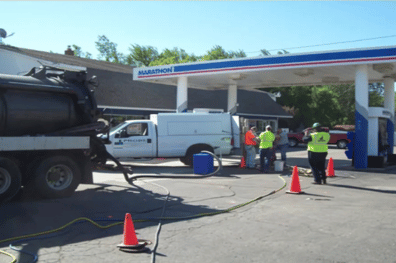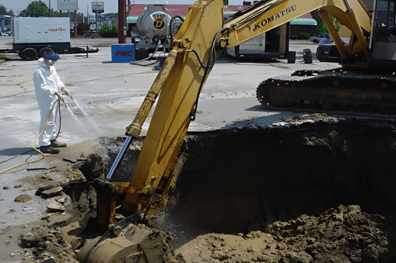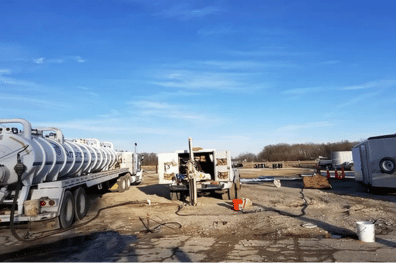ORIN successfully implemented Free Product Removal (FPR) in-situ chemical oxidation using catalyzed sodium persulfate to treat LNAPL, contaminated soil, and groundwater. Treatment chemistry was injected while the Geoprobe rods were raised throughout the target interval. A vac truck was present to remove LNAPL
and desorbed contaminants while providing hydraulic control.
Approximately 2,400 gallons of 20% sodium persulfate catalyzed with PermeOx Plus was injected into 47 DPT injection locations. A second polish injection was needed to achieve site cleanup goals. In June of 2011, 24 DPT points were injected with approximately 1,200 gallons of 20% catalyzed sodium persulfate treatment.
The Challenge
The site presented complex operational requirements:
- Active gas station operations
- LNAPL contamination
- BTEX contamination
- Need for minimal business disruption
- Multiple contamination phases
- Need for sustained treatment
The Solution: Two-Phase Treatment Strategy
The team implemented a comprehensive approach:
- Initial Treatment Phase:
- 47 DPT injection locations
- 2,400 gallons of treatment solution
- 20% sodium persulfate
- PermeOx Plus catalyst
- Integrated vacuum extraction
- Polish Treatment Phase:
- 24 additional DPT points
- 1,200 gallons of solution
- Targeted problem areas
- Enhanced treatment effectiveness
Implementation Strategy
Key operational elements included:
- Dynamic injection during rod withdrawal
- Continuous vacuum truck operation
- Active hydraulic control
- LNAPL removal
- Desorbed contaminant capture
- Minimal site disruption
Impressive Results
The treatment achieved multiple objectives:
- Complete LNAPL elimination
- 78% BTEX reduction in most contaminated well
- No measurable LNAPL in subsequent monitoring
- Continued oxygen release for bioremediation
- Maintained business operations
Key Success Factors
Several elements contributed to project success:
- Strategic phased approach
- Comprehensive injection coverage
- Active contamination removal
- Sustained treatment effects
- Operational flexibility
Innovation Highlights
The project demonstrated several advantages:
- Effective during active operations
- Multiple contaminant phase treatment
- Long-term treatment benefits
- Minimal business impact
- Sustainable remediation
Practical Applications
This approach provides solutions for:
- Active gas station remediation
- Complex contamination scenarios
- Business-sensitive projects
- LNAPL/BTEX treatment
- Phased treatment programs
This case study shows how innovative treatment approaches can achieve environmental goals while protecting business operations.



